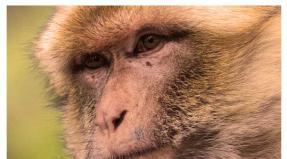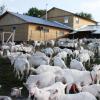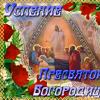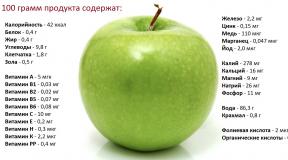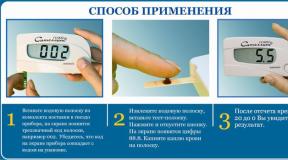Birth of Jesus Christ. Biblical scenes in Russian painting Pencil drawing of the birth of Jesus Christ
), and thus the feast of the Nativity, celebrated together with Theophany, was celebrated in the East on January 6th. The exact division of these holidays in the entire Christian Church - Western and Eastern - occurred at the end of I Y - the beginning of V century. As Church historians (M. E. Posnov, in particular) note, the feast of the Nativity of Christ was borrowed by the Eastern Church from Rome, while the feast of the Epiphany first appeared in the East, and then was already transferred to Rome. It is also necessary to point out here that the Western and Eastern Churches over time began to invest different meanings in the concept of Theophany, which was reflected in the choice of the events of the gospel history celebrated on this holiday. Thus, the Eastern Church established itself in the celebration of Theophany as the Baptism of Christ - the first appearance of Jesus among the people and the establishment of the dogma of the Trinity - the idea of the appearance of the persons of the Godhead. In turn, the Roman Catholic Church, under Theophany, also celebrated on January 6, implies the appearance of a star to the Eastern Magi as the first revelation to the pagans of the appearance of the Messiah (the feast of the Three Magi, Three Kings). Epiphany, in the event that Sunday, when it is always celebrated, does not coincide with January 6, is celebrated by the Roman Catholic Church on the first Sunday after this date.
The above circumstances are extremely important for a correct understanding of the Christmas cycle of plots, as it was formed in Western art. The gospel story of the birth of Christ is, in fact, only the words of Luke cited above. Often, however, in Western art, under the name "Nativity of Christ" are also meant scenes Adoration of the shepherds and Adoration of the Magi (in this case, we are not talking about interpretations of the plot of the birth of Christ that are not based at all on the gospel narrative, for example, the worship of Mary, the worship of kings, and others - about these interpretations and their literary programs, see below), while the episode Adoration of the Magi, strictly speaking, is the scene of the Epiphany. Moreover, if the pictures on the plot Birth of Christ, as a rule, include subsequent episodes, which, in essence, form a circle of episodes of the feast of the Epiphany, then the scenes of this last feast - Adoration of the Magi, Adoration of kings- by no means always include the image of the actual birth of Christ.
So, we deliberately separate the plot of the actual birth of Christ, as direct illustration of the story of Luke, from the following plots of the Adoration of the Shepherds and the Adoration of the Magi (kings), as indirect proof of the birth of Christ. It should be noted that the combination of these subjects in painting reflected the initial confusion by the Church itself of the circumstances of the birth of Christ and his appearance, that is, the holidays of Christmas and Theophany.
The first source from which Christian artists borrowed the basic idea of the birth of Christ must have been the Gospel. Matthew only states the fact of birth: “At last she gave birth to the Son of her firstborn, and he [Joseph. - A. M.] called His name: Jesus” (Matt. 1:25). It happened in Bethlehem. Luke's story is somewhat more detailed: he mentions the absence of a place in the hotel, that Mary swaddled the Baby, that He was placed in a manger. From Luke's further account it becomes clear that Joseph was present at the birth (Luke 2:16). But if we compare with these testimonies of the gospel the images of the birth of Christ in painting, it becomes clear that they include details that are not in the gospel. Thus, the iconography of the Birth of Christ, while preserving what the Gospel gives, goes further in the development of external details. These include the place where the birth of Christ took place, the manger in which the Savior was laid, the ox and donkey at the manger, the star above the image of the scene of the birth of the Infant, the position of the Mother of God who gave birth, the actions of Joseph, Angels and shepherds, the washing of the Infant, midwives and their behavior, features stage architecture. For all these details of the plot, there is a theological base and literary programs.
The first images of the birth of Christ belong to the era of ancient Christian sarcophagi, but date back no earlier than IV century. The scene, as a rule, is very simple: a swaddled Baby lies in a manger under a canopy, an ox and a donkey bend over him, Mary and Joseph are present, sometimes shepherds are depicted. Often, when a star appears, as on one of the Roman sarcophagi found onVia appia, we also see three magi (in Phrygian caps).
So, if we do not limit ourselves only to the testimony of Luke, but try to identify a wider range of literary sources for the theme of the Birth of Christ, then it turns out that this plot breaks up in Western art into several iconographic types firmly established by the Renaissance. To outline them, it is necessary to consider a number of “motives” included in this plot and find out their literary program: 1) Arrangement of the Virgin Mary (in a house [under a canopy] or in a cave); 2) Two maids and washing of the Child; 3) Worship of the Child; 4) Star; 5) Angels; 6) Flowers; 7) A handful of hay; 8) Shoes. Let's consider them sequentially.
DEVELOPMENT OF THE VIRGIN MARY (IN THE HOUSE [UNDER THE CANOPY] OR IN THE CAVE)
With the determination of the place where the scene of the birth of Christ should be placed, artists have always had many problems. On the one hand, they relied on the testimony of Matthew: “And entering the house (...)” (Matt. 2:11). Matthew's speech here it is about the magi who came to bow. But, strictly speaking, the Magi appeared many later, in order to consider their arrival "in the house" as proof that the very the birth of Christ took place here. However, early artists preferredTali precisely so to interpret the place of action of this plot. It can be stated that in the early images of the birth of Christ, the action takes place under canopy,which symbolizes the house. During the Renaissance, artists depictedthe house where the Virgin Mary gave birth, in the form of a dilapidated building (shack) - shesymbolized the Old Testament, to replace which Christ appeared in the world with the New( ).
Robert Campin. Birth of Christ (1425). Dijon. City Museum ).
The choice by artists of another place for the giving birth of the Virgin Mary - caves -based on the mention of her by Justin Martyr in his "Dialogue with Tryphon" ( II century), who saw in such a birth of Christ the fulfillment the prophecies of Isaiah; cf .: “When the performers of the mysteries of Mithra say that hewas born from a stone, and the place where they initiate those who believe in it is called cave, do I not see that they borrowed it from the words of Daniel (...) and also from the prophet Isaiah (...)?” (Justin Martyr. "Dialogue with Tryphon", 70)the prophecy of Isaiah: “He will dwell on high; his refuge- impregnable rocks” (Isaiah 33:16). This tradition is clearly stated in many apocries.physical texts, in particular in the Protoevangelium of James (which, apparently mu, Justin Martyr knew), which says: “(17) And he took Her off the donkey and said to Her: Where can I take You and hide Your shame? For the place is deserted. (18) And he found a cave there, and brought her (...) ”(Protevangelium, 17- eighteen). Can indicate other literary sources of this pictorial tradition. First images of the birth of Christ in a cave refer to VI-VII centuries. In the cave depicted the birth of ChristPietro Cavallinion his mosaicchurch of Site Maria in Trastevere in Rome.
Pietro Cavallini. Birth of Christ (1291). Rome. Church of Site Maria in Traste faith.

In general terms, his compositionfollows the canons of Byzantine iconography, but in pictorial forms bears the mark of the Roman tradition. This fresco is unusually interesting becausecombines several literary programs–testimonies of the Gospel of Luke, the Gospel of Matthew, the Protoevangelium of James, and in addition, contributeslocal - Roman - detailing the interpretation of the plot. Luka borrowed the artistshaft: 1) hotel picture–a house with a tower in the foreground; inscription explains: "taberna meritoria"(lat. –rental dwelling) (“they weren’tplaces in the hotel. OK. 2:7), 2) the gospel to the shepherds: An angel with a parcel, on which text:
« Annutio uobis gaudium magnum»
(lat. - “I announce to you great joy." OK. 2:10).
From Matthew, the artist borrowed a star, whichbrought the Magi to Bethlehem. At Jacob (from the Protoevangelium) - a cave, in to whom the Virgin Mary gave birth, as well as the image of Joseph frozen in thought:“... and went to look for a midwife in the Bethlehem district. And so I, Joseph, walked and didn't move. And looked at the air and saw that the air was still, looked at the vault of heaven and saw that it had stopped and the birds of the air stopped in flight (...) ”(Protoevangelium, 18). And finally, your contribution tothe development of the program for this mosaic was introduced by Cardinal Jacopo Stefaneschi, known philanthropist of the early trecento: in the foreground next to the hut and the tower is visible source of fragrant oil, which, according to legend, scoredin Rome at the time of the birth of Christ. Above this source was placedChurch of Santa Maria in Trastevere, as evidenced by the inscription under picture:
« Jam puerum jam summe pater post tempora natum / Accipimus gentium tibi quem nos esse coevum / Credimus hipcqi clei scaturire liquamina Tibrum»
(lat. - “He, the Infant and the eternal Father, as an equal to us, as a contemporary, was born among us. We believe that peace (mercy) pours out from here, like the waves of the Tiber”).
Only to those who do not know what a khan is, that is, a hotel in the East - one in which Joseph and Mary could stay - it may seem that the testimonies of Luke and Matthew do not agree with each other. In fact, "house" and "cave" can mean almost the same thing. The khan or caravanserai in the East was a low building, the walls in its rooms were only on three sides, and everything that happened in the room was open to the eyes of an outsider. There was also a place (courtyard) for cattle, and the room was separated from the courtyard by only a few steps. But the most interesting thing from an archaeological point of view is that the khans were built, or rather, attached to the numerous caves in those places. It was one. Thus, the attempts of artists known to us to reconcile these two testimonies, depicting the entrance to the cave and a canopy above it (Botticelli).
Sandro Botticelli. Birth of Christ (1500). London.
National Gallery.

Wed With Giotto. Birth of Christ (1304 -1306). Padua. Scrovegni Chapel ;
cm. Adoration of the Magi), are not so sinning against the truth.
TWO SERVANTS AND THE WASHING OF A CHILD
Sometimes the birth of Christ is interpreted by artists as the birth scene itself (cf. BIRTH AND NAME OF JOHN THE BAPTIST AND THE BAPTIST). In this case, two midwives are depicted (Salzburg (?) Master).
Salzburg (?) master. Birth of Christ (c. 1400). Vein.
Gallery of Austrian Art.

We learn the details of this story from the same Protoevangelium of Jacob: the midwife that Joseph found witnessed the birth of the Savior (“Salvation was born to Israel”); she told Zelomia (otherwise, Zelemia, who met her) about this; And Salome said: The Lord my God lives, until I stretch out my finger and check her virginity, I will not believe that a virgin has given birth. (20) And just as Salome held out her finger, she cried out and said: Woe to my unbelief, for I dared to tempt God. And now my hand is taken away as if on fire. And she fell on her knees before the Lord, saying: Lord God of my fathers, remember that I am from the seed of Abraham, Isaac and Jacob, do not shame me before the son of Israel, but show me mercy for the sake of the poor: For You know that I served You in the name of Yours and from You I wanted to receive retribution. And then the Angel of the Lord appeared before her, and said to her: Salome, Salome, the Lord has listened to you, put your hand to the Baby and support Him, and salvation and joy will come for you. And Salome came up and took the Child in her arms, saying: I will worship Him, for the great king of Israel has been born. And immediately Salome was healed and came out of the cave saved ”(Protoevangelium of James, 19-20).
The name of the second midwife, according to tradition, the one that did not doubt the divine origin of the Infant, is Zelomiya.
As for the bathing of the Infant by midwives, there is no story about this either in the Apocrypha or in other monuments of ancient writing. The artists conceived this scene based on the fact of the presence of midwives. But the sinlessly born Infant did not need any cleansing (washing). Moreover, he did not need the midwives themselves. Their persistent presence, however, in the paintings of the old masters can be explained by the desire to have witnesses of the miraculous birth of Christ.
The theme of the Adoration of the Child (see below) is often connected with the motif of the Two Servants, as well as other plots directly adjacent to the plot of the birth of Christ, in particular the Annunciation to the Shepherds or the Adoration of the Shepherds ( Kampen ). Here we recognize the maids not only by the characteristic gesture of Zelomia's "paralyzed" hand, but also by the words that are inscribed on the parcels of the characters. So, in Zelomia, depicted with her back to the viewer, the tape is inscribed:
« Virgo peperit filium»
(lat. - "The virgin gave birth to a son")
Zelomiya has, firstly, her name and, secondly, the words:
« Credam cum probavero»
(lat. - “I will believe when I clearly imagine”])
From the Angel addressing Zelomiya:
« Ta, puerumet sanaberis»
(lat. - “Touch the Baby and you will be healed)
This treatment of the theme of the Birth of Christ disappeared after it was condemned by the Council of Trent (1545-1563).
CHILD WORSHIP
The cult of piety, which in various forms spread widely in XIV – XV centuries, its roots go back to previous centuries - XII – XIII century. It grew out of the mysticism of Bernard of Clairvaux (1090 - 1153), the founder of the Bernardine order, the grain of whose teaching was love for the Christ Child and for Christ the Passion-Bearer, as well as for the Virgin Mary. Yakov Vorraginsky often quotes Bernard in The Golden Legend. He, in his discussions about the birth of Christ, pays special attention to the poverty of the environment in which it took place. Francis of Assisi (1181/2 - 1226) brought the cult of "holy poverty" to its limit.
The work of the Franciscan monk Giovanni de Caulibus (Pseudo-Bonaventure), in particular, his “Meditaciones vitae Christi"("Reflections on the Life of Christ"), as well as Brigid of Sweden (c. 1304 - 1373), a seer who visited Jerusalem in 1370 and managed to publish two years before her death "relations de vita et passione Jesu Christi et gloriosae virginis Mariae matris eius"("Revelations about the life and passions of Jesus Christ and the glorious Virgin Mary, His Mother"). The revelations of this nun very soon became known to contemporaries. This is confirmed by the fact that her descriptions, in particular, of the scene of the Nativity of Christ, soon after the publication of her work began to be reproduced in paintings that interpreted this plot as the Adoration of the Child (sometimes the artists depicted even herself in the costume of the Brigitte Order, which she founded).
Since both texts - by Giovanni de Kaulibus and Brigid of Sweden - relating to this plot are extremely important for understanding the details depicted by the artists, we will cite them in full.
GIOVANNI DE CAULIBUS (PSEUDO-BONAVENTURA)
“When the time came to give birth—it was about midnight on Christmas Day—Mary stood up and leaned against the pillar that was there. Joseph sat next to him, saddened, probably because he could not prepare everything necessary for the birth. He got up, took hay from the manger, placed it at the feet of the Virgin Mary and turned away. At that moment, the Son of God left the womb of the Mother without causing her any pain. So He ended up in the hay at the feet of His Mother. After washing Him, She wrapped Him in Her veil and laid Him in a manger. We were told that the ox and the donkey bowed their heads over the manger in order to warm the Infant with their breath, as they understood that in such a cold, the barely sheltered Infant needed warmth. Mother, however, kneeling down, prayed and gave thanks to God: I thank You, Lord and Heavenly Father, for having given Me Your Son, and I pray to You, the Eternal God, and to You, the Son of the Living God and My Son.
BRIGIT OF SWEDISH
“When I appeared before the manger of the Lord in Bethlehem, I saw a Virgin of extraordinary beauty (...), tightly covered with an elegant tunic, through which the virgin body was clearly visible (...). Together with her was the most virtuous old man, he brought an ox and a donkey; they entered the cave and the man tied the animals to the manger. Then he went out and brought a candle to the Virgin, attached it to the wall and went out, so that at the birth of the Baby he was not there. Meanwhile, the Virgin took off Her shoes, threw off Her white cloak that covered Her, took off the veil from Her head, put it at Her side and remained in one tunic, with wonderful golden hair falling loose on Her shoulders. Then She took out two small pieces of linen and two pieces of wool, which She brought with Her to wrap the Baby who was destined to be born in them (...). And when everything was ready, the Virgin, with great reverence, knelt in the pose of prayer and turned her back to the manger, Her face was turned to the east, and her gaze was directed to the sky. She was in ecstasy, immersed in contemplation, She was overwhelmed with admiration for divine tenderness. And standing thus in prayer, She suddenly discovered that the Infant was stirring in Her womb, and unexpectedly She gave birth to a Son, from Whom emanated indescribable light and brilliance, so that the sun could not compare with Him, and even more so the candle that Joseph set here, the divine light completely swallowed up the material light. And this birth was so unexpected and instantaneous that I could neither detect nor understand through which member of her body She gave birth. I saw a Baby coming from nowhere, lying on the ground, naked and radiating light. His body was completely clean. Then I heard the singing of the Angels, it was unusually gentle and beautiful. When the Virgin realized that she had already given birth to Her Baby, She immediately began to pray to Him: Her head bowed and her arms crossed over her chest. With the greatest reverence and reverence, She said to Him: “Glory to Thee, My God, My Lord, My Son.”
Examples of scrupulous adherence to literary sources describing the birth of Christ, and primarily the works of Giovanni and Brigitte, can be paintings on the theme of the Adoration of the Child by the Dutch artists of the golden age of painting in this country. A classic example is the "Adoration of the Child" by Rogier van der Weyden in the triptych of the so-called "Bladelen Altarpiece" (otherwise called the "Middelburg Altar") (Rogier van der Weyden. Adoration of the Child (Bladelen Altarpiece) (1446-1452). Berlin-Dahlem. Picture gallery of the State Museum). Thus, here is a column, against which, according to Giovanni, the Virgin Mary leaned (the column in the plot of the Adoration of the Child plays a double role: as a detail of Giovanni's story and as an allusion to the future sufferings of Christ, when he, tied to the column, will be scourged; see fig. THE FLAIGING OF CHRIST. The column became one of the instruments of the Passion of the Lord; it appears in the hands of the Angels in the scenes where they carry these tools). The “most virtuous old man,” a candle whose light is drowned out by the miraculous glow of the Child, all this is borrowed by Rohyr from Brigid. According to her description, the artist also created the image of the Virgin Mary - in a white chiton, with flowing golden hair, standing in a prayerful pose. Often, Jesus answers Mary's prayer with a movement of his hand, which can be considered a blessing gesture ( ).
Unknown master from Avila. Birth of Christ (1464-1476). Madrid. Lazaro Goldenano Museum

GUIDING STAR
At first glance, the frequent images of a star in the scene of the Birth of Christ have a simple explanation: this is the star that appeared to the Magi and led them to the birthplace of Christ. Perhaps, in most cases, the artists included this motif in the scene of the Birth of Christ, based on the idea that the star appeared at the moment of the birth of the Child. The adoration of the Magi with a star is such a common iconographic type (cf. Adoration of the Magi), which seemed natural to use a star in this case.
However, in this story, the star may have a different explanation. In the Protoevangelium of James, which, as we have already seen, was widely used as a literary program, there is no direct reference to a star, but only an extraordinary light in the cave where Christ was born. And if this source was the basis for many other iconographic "motifs", then it is quite reasonable to assume that it also explains the image of a bright light in a cave with the help of a traditional image - a star. In this case, it would be erroneous to see in this star always and only the star of the Magi.
ANGELS
A host of praying and singing hymns of angels is mentioned by both Giovanni and Brigid. We see them in Rogier van der Weyden and many other artists. The number of angels can have a symbolic meaning. So, in the "Adoration of the Child" fifteen are depicted on them.
Hugo van der Goes. Altar Portinari. (1473-1475). Florence.
Uffizi Gallery.

We find an explanation of the symbolism of this number from a contemporary and compatriot of the artist, preacher of the Dominican order, Alan van der Klip (Alain de la Roche, 1428 - 1475): the complete cycle of prayers of the Brotherhood of the Rosary, to which this preacher belonged, contains fifteen prayersPater
Noster" ("Our Father"); alternating with one hundred and fifty prayers" Ave
Regina", they symbolize the fifteen events of the PassionChrist. "15" is also the number of virtues: 4 "cardinal" (courage,wisdom, moderation, justice), 3 "theological" (faith, hope,love) and 7 “basic” ones (humility, generosity, chastity, contentment with one’s own, temperance, calmness, hope) and 2 more - piety and repentance. There are sixteen in all, but moderation and abstinence in essences are the same. In this way different there are only fifteen virtues. And finally, another possible explanation for the number 15: this is the number of "psalmsascension" (ascension song)– psalms 119 – 133. According to their number, it is acceptedalso depict the number of steps of the temple in the paintings "Introduction of the VirginMary in the temple "(see the Dresden painting by Cima da Conegliano" Introduction of the Virgin Mary to the temple). Another number of steps in the plot "Introduction of the Virgin Mary to the temple” -10- symbolizes the Ten Commandments (see Ghirlandaio. History of Mary: a) Birth of Mary, b) Entry into the temple. Florence. Church of Santa Maria Novella. Chapel of Tornabuoni)
GLORIA
Often artists, especially Dutch ones, give muses to angels.rock instruments and notes, and if these notes reproduce realmusical works, which was also done quite often, then these are hymns onLatin text from Luke:
« Gloria in Excelsis Deo et in Terra Pax Hominibus Bonae Voluntatis »
(lat. - “Glory to God in the highest, and on earth peace, and goodwill towards men.”
OK. 2:14)
Cm.: . Birth of Christ (1512). Naples. National Museum and Galleries of Capodimonte
Jacob Cornelis van Ostzanen. Birth of Christ (1512). Naples. National Museum and Galleries of Capodimonte

In the book which holds an angel in the foreground of the picture, a four-part hymn is recorded on this text, all four musical parts - bass, tenor, alto and soprano - are easy to read. Angels sing this hymn on different instruments - shawls, trumpets, psaltery; many singing and playing angels but also in the background; there are thirty-three angels in all, which corresponds to the number of years lived by Christ.
From a musical point of view, the engraving “Annunciation to the Shepherds” by a Dutch master is extremely interesting. XVI century Johannes (Jan) Sadeler the Elder "Annunciation to the Shepherds" (based on the composition of Marten de Vos).An angel in the center holds a parcel with the text from the Gospel of Luke:
Ecce enim evangelizo vobis gaudium magnum quod erit omni populo quia natus est vobis hodiesalvatorqui est Christus Dominus [in civitate David]
(Lat. - Do not be afraid; I proclaim to you great joy, which will be for all people: for today a Savior has been born to you in the city of David, who is Christ the Lord. - Lk. 2, 10 - 11).
At the angels soaring in the sky of the part of the nine-part motet "Gloria in Excelsis» . All musical parts are reproduced very accurately.
Johannes (Jan) Sadeler the Elder. "Annunciation to the Shepherds" (based on the composition of Martin de Vos).

Millions of people believe in Jesus Christ, although his existence is controversial. He is admired, loved, worshiped. As stated in the Bible, and in accordance with Christian beliefs, the Lord God impregnated the Virgin Mary. She gave birth to Jesus, who performed incredible miracles: walked on water, gave sight, turned water into wine, healed the crippled and raised the dead. Many professional artists and just art lovers depict Jesus Christ in their canvases, but children's drawings drawn with an ordinary pencil carry a special energy.
The drawings depicting Jesus Christ are very convincing. They not only give a visual representation of a person, but also speak about his essence.
It would seem that the portrait shows something quite obvious, but the author cunningly “hides” a deep meaning in it. Through a certain expression or pose, an additional object (a wreath of thorns) or the use of certain colors, the artist reveals the soul of a great man.

Often the work becomes iconic, representing a group of people from a particular time period who share something in common, such as the birth of Jesus.

Even one cradle with the Star of Bethlehem at its head speaks of the birth of our Savior.

Sometimes, it seems that the face of Christ has a stern or frowning look, but this is an erroneous opinion. Christ is our salvation and his gaze is always loving.

When depicting the Almighty, it is important to draw the eyes correctly - the gates to the human soul.

Sometimes one eye is depicted facing the viewer, and the other is turned slightly to the side. It is said that this is how Jesus looks at his destiny.

It is through the shape of the neck that the authors convey the full breath of God and the holy spirit.

The Almighty came to our earth to save and protect all mankind.


Pencil drawing of the crucifixion of Jesus Christ, a diagram of the drawing in stages
Jesus Christ gives people hope, trust and faith. Looking at the images of the crucifixion of Jesus Christ, you really believe that he died for our sins. Drawing such events requires the author to understand and adore a really great sacrifice.
Option number 1
There are six specific steps, after which you can create a suffering picture of the Almighty.
- To begin with, they are determined with the shape of the body. Start with a circle for the head and an elongated torso. After creating the base, add limb lines for the neck, arms and legs.

- Proceed to a sketch of shoulder-length hair, a sketch of a beard and a crown of thorns. The shape of the body and arms are rounded.

- When the upper body of Jesus is ready, you can draw the shape of the cross. Having finished the outlines of the arms, proceed to the waist, loincloth and legs.

- The next step is to draw the elongated wings. Add fabric with fold lines on the lower back. Then they go down, where they finish drawing the lower part of the cross.

- Feathers are added to the large angel wings and the original lines drawn in the first step are erased.

- The sketch of the drawing is ready, although you can add some shades.

Option number 2
Before you start drawing Jesus, determine the size of the figure. Accordingly, the silhouette is selected based on the height of the sheet. This is necessary to maintain the proportion between the sheet and the actual drawing.
- Initially draw a cross. It will serve as the basis for the body. The pressure of the pencil is not great, so that at the end of the work it is easy to erase the guides.

- Determine the space that the drawing will occupy vertically and horizontally. The arms of Jesus will be stretched out to the sides. Therefore, a good paper size is required. Draw the head and hands. At the top of the vertical line, make an oval for the head.

- Draw a large rectangle that will serve as the torso. Then draw the details of the hair, eyes, nose, lips and beard.

- Begin to detail the drawing with the hair. For this, wavy or straight lines are depicted, starting at the top of the head and falling to the shoulders.

- Do not worry if the strands do not look even.

- Work with the face. Eyebrows are drawn a little below the forehead, and under them - eyes (necessarily with a pupil), adding two stretched curved lines. Then proceed to sketch the nose and mouth.

- The lips should be slightly curved upwards, so the masters show the smile of Jesus. Around them make a mustache and a beard. The first vegetation is shaded vertically, and the second is performed horizontally. The beard starts from the lips and extends to the ears. It looks like a triangle pointing down.

- Then make two ovals at the end of the arms. Later, fingers will be drawn from them, which will be bent upwards.

- Long lines depict a robe, not forgetting to make extra strokes for the folds on the clothes. Darken or shade on the fold lines, for example, on the folds. They form fingers on the hands and pass once again along the contour of the drawing. Remove unnecessary details with an eraser.

- Option number 3
Step by step video drawing guide of the crucifixion of Jesus. The author shot it in some detail, so it is quite possible to repeat the above technique.
Pencil drawing of the birth of Jesus Christ, step by step with a photo
When they draw an important Christian event - the Nativity of Christ, they immediately remember the crib in the manger, where the baby first appeared. The scenes are accompanied by the magic of the night star, wandering shepherds, domestic animals, exotic magi bringing gifts from the East, as well as a proud father and Mother of God.
Option number 1
This drawing is in the form of a greeting card.
- To begin with, they make a circle in which the animal nursery is placed.

- Then a lying baby wrapped in a sheet is depicted in the feeder.

- Grass protrudes from the cracks and over the manger.

- The next step is to add the sheep, the glow around the baby's head and the glow of the Star of Bethlehem.

- You can add bells, spruce branches and a congratulatory inscription. Branches are made from the curve from which other small branches come.

Option 2
To draw the birth of Jesus, it is not necessary to depict all the details of the event. Sometimes it is enough to show a baby in a cradle on a haystack.
- First, create an elongated shape for the head. Just below its center, a horizontal line is drawn to place the eyes.

- From the right end of the line make a slight bulge for the cheeks. Nearby draw a brush pen with tiny fingers.

- Eyes are placed on the drawn horizontal line, eyelashes and eyebrows are drawn. Between the eyes make a rounded nose, and then the mouth and lips. Be sure to make curved dashes at the corners for roundness of the cheeks.

- Then they draw a light line of hair and proceed to the image of the second hand, which is shown from under the blanket.

- They lengthen the body of the baby and add the edges of the basket, on top of which the edge of the blanket falls.
The basket can be depicted in different shapes, it all depends on the imagination of the author.

- Extra details are removed with an eraser.
 The birth of Jesus Christ in color, step by step with a photo
The birth of Jesus Christ in color, step by step with a photo
What is Christmas without a nativity scene? The following figure is for more experienced authors. The Christmas action is crowned by the Star of David above the feeder. The baby himself sleeps peacefully in a basket filled with hay. Next to him are Mary and Joseph, and lambs lie on the sides.
- Make ovals for all six characters participating in Christmas.

- Further, they are determined with the forms of people, angels and animals.

- Knowing where each character is located, they begin to draw the corresponding faces. The child is sleeping, so his eyes are closed, and hoods are thrown over the heads of Joseph and Mary.

- They begin to draw the bodies and clothes of the heroes, as well as the curls of sheep's wool.

- They proceed to the wings of an angel, as well as halos above the heads of Mary and Joseph. They draw a blanket with which the baby is wrapped.

Drawing Jesus Christ superstar, step by step with a photo
The attitude to the musical "Jesus Christ Superstar" is ambiguous, because the whole production is based on rock songs. The storyline is based on the last days of Jesus' life and contains many elements of the biblical narrative: the betrayal of Judas, the arrest and crucifixion of Jesus.
Drawing No. 1 The versatility of the greatness of Jesus
In this picture, Jesus is looking a little to the side. He has a pensive and tired look, but a glow comes from the face of the saint.
- They start by drawing an oval, which is separated by a vertical line for the elements of the face. Around the contour make wavy strands of hair and a slanting line for the shoulders.

- Detailed hair for greater realism. Apply two loops on the left side, which will later become the ear. Then strokes are drawn for the eyes, nose and beard.

- Continue sketching out the front hairline that surrounds part of the face. Form the eyes, and impose a shadow on the right side.

- Outline the location of the mustache and beard, continue to detail the neck and chest area.

- At the fifth stage, the shading process begins with the area around the eyes, which will add depth and realism to the face. Repeat the same with the left eye, moving further down to the cheek. Lightly shade the area around the tip of the nose, lips and mustache. The hair lines above the forehead and the robe should also be shaded.

- Delete all the guiding shapes and continue shading the entire top of the head, mustache and beard.
Drawing Christ is a request for the blessing of all thoughts and undertakings, as well as the maintenance of Christian teachings and a book containing Scripture. A strong portrait always fascinates and attracts the attention of the viewer. He makes us think about a great man who devoted himself entirely to serving people.
Birth of Jesus Christ
Birth of Jesus happened like this.
When Joseph heard that Mary was expecting a child, he was confused. Maria had not yet become his wife, and he could not understand who was the father of the child.
The Lord sent His angel to Joseph. In a dream, an angel told him: “Do not be afraid, Joseph, to accept Mary as your wife. She will have a Son from the Holy Spirit, name the baby Jesus, which means: “Savior”, for Jesus will save people from sins.
Joseph calmed down. Shortly before the birth of Jesus, he came home preoccupied. The Roman ruler, Caesar Augustus, wanted to establish how many people lived under the dominion of Rome. Therefore, he ordered a census to be taken throughout the country. All residents had to go, each to their own city, to enroll there.
Joseph was born in Judea, in the city of Bethlehem, located one hundred and sixty kilometers from Nazareth.
Mary, who was expecting the birth of her Son, and Joseph were forced to go on an exhausting journey. They moved slowly forward.
When Joseph and Mary finally arrived in Bethlehem, all the places in the hotel were already taken. The owner sympathized with them and offered his stable for the night. It so happened that the Son of God was born among the animals in a manger.
This event did not go unnoticed. Soon the first guests arrived. Shepherds in the fields of Bethlehem suddenly saw a bright light in the night. An angel appeared to them and announced the joyful news of the birth of the Lord.
"Do not be afraid! For today a Savior was born to you in the city of David. This is Christ, the Lord. And here is a sign for you: you will find the Baby in swaddling clothes in the manger!”
When the shepherds looked up into the sky, they saw a numerous host of angels who sang: “Glory to God in the highest, and on earth peace to all people who love God!”
Then the light went out and the angels disappeared. Silence fell again, and only the stars shone as before.
The shepherds got up. “Let's go to Bethlehem and try to find the Baby,” they decided and set off on their way, finding with difficulty a narrow path in the darkness.
Holding their breath, they entered the barn.
And here, in the manger, lay the Infant Jesus, wrapped in warm swaddling clothes. Everything was exactly as the angel had predicted for them. Mary and Joseph sat next to each other.
The shepherds quietly knelt down and bowed to the Child. Then they told Mary and Joseph what the angels told them.
When the shepherds returned to their flocks at dawn, they met the first travelers on the streets and told them about the Good News.
Maria remembered everything and kept it in her heart. When the time came, Mary and Joseph went to the temple and carried the Child there, as required by Jewish law.
They named the baby Jesus, as the angel told them.
Nation of Jesus Christ
People of Jesus thought so.
If Josip knew that Mary was looking for a child, he was ruined. Mary has not yet become his retinue, and I didn’t have a moment to understand who the father of the child is.
The Lord sent His angel to Josip. In a dream, an angel said to you: “Do not fight, Josip, accept Mary, your squad. She will be born Sin in the form of the Holy Spirit, call the name Jesus, which means: “Savior”, for Jesus is the god of sin.”
Josip calm down. Not long before the people of Jesus, we came to the house of turbovanim. The Roman ruler, Caesar Augustus, having wanted to restore, how many people live under panuvannya Rome. Tom vin punishing to conduct a census throughout the country. All the inhabitants were guilty of going, they were at their own place, so that they could sign up there.
Josip was born in Judea, in the city of Bethlehem, roztashovanomu one hundred and sixty kilometers from Nazareth.
Mary, who was checking the people of Sina, and Josip was zmusheni, he was restored to tight clothes. The stench povitalis protruded forward.
If Josip and Mary came, arrived, to Bethlehem, all months in the hotel were already occupied. Gospodar after sleeping with him and proponing his crib for nothing. So it happened that the Son of God was born among the creatures at the manger.
Podiya did not pass unmarked. The first guests arrived unexpectedly. The shepherds in the fields of Bethlehem thrashed with rapt in the night when it was bright. The angel appeared to them and sent a radio call about the people of the Lord.
“Don't fight! This year, the Savior was born to you at the place of David. Tse is Christ, the Lord. І axis is a sign to you: you will know Ditina will wake up in a manger! ”
When the shepherds looked at the sky, the stench roared the number of the army of angels, like they sang: “Glory to God in the cherries, and on earth peace to all people who love God! ”
Then the light went out, and the angels appeared. Silence came again, and the stars shone less, as before.
The shepherds rose. “Let’s go to Bethlehem and try to rozshukati Nemovlya,” the stench blew and broke on the road, forcibly knowing in darkness a knotted stitch.
Zatamuvshi podikh, vyyshli stench in the barn.
And here, in the manger, Nemovlya Jesus lay down, curled up in the warmth of pelushki. Everything was exactly the same, as if an angel had passed it on to him. Maria and Josip sat in charge.
The shepherds quietly knelt down and bowed to Nemovlyat. Then the stench rose to Mary and Josip, about which the angels told them.
When the shepherds turned on their sweaters to their flocks, the stench, ringing on the streets of the first road, told them about the Good News.
Maria remembered everything and kept it in her heart. When the hour came, Mary and Josip went to the temple and carried Ditina there, as if he were in compliance with the Jewish law.
The stench was given to the Unmoved Name by Jesus, as if an angel had told them.
The birth of Jesus Christ is one of the most important events in the universe. God Himself appeared to us in the flesh! Let's step by step remember and reflect on this amazing moment in history. At that time there were no photos and videos, but we can at least partially touch Christmas by looking at pictures about Christmas.
(Pictures Christmas #1)
(The appearance of the angel Gabriel to Mary)
Gospel of Luke 1:25-38
26. In the sixth month, the Angel Gabriel was sent from God to the city of Galilee, called Nazareth, 27. to the Virgin, betrothed to a man named Joseph, from the house of David; the name of the Virgin: Mary. 28. An angel, entering to her, said: Rejoice, full of grace! The Lord is with you; blessed are you among women. 29. But when she saw him, she was troubled by his words and wondered what kind of greeting it would be. 30. And the angel said to her: Fear not, Mary, for you have found grace with God; 31. And behold, thou shalt conceive in the womb, and bare a Son, and thou shalt call his name: Jesus. 32. He will be great and will be called the Son of the Most High, and the Lord God will give him the throne of David his father; 33. And he shall reign over the house of Jacob forever, and his kingdom shall have no end. 34. Mary said to the angel: How will it be when I do not know my husband? 35. The angel said to her in answer: The Holy Spirit will come upon you, and the power of the Most High will overshadow you; therefore, the holy being born will be called the Son of God. 36. Here is Elizabeth, your relative, called barren, and she conceived a son in her old age, and she is already six months old, 37. for no word will remain powerless with God. 38. Then Mary said: behold, the Servant of the Lord; let it be to me according to your word. And an angel departed from her.
(Pictures Christmas #2)

(Meeting Mary with Elizabeth)
Gospel of Luke 1:39-45
39 And Mary arose in these days, and went with haste into the hill country, to the city of Judah, 40 and entered the house of Zechariah, and greeted Elizabeth. 41. When Elizabeth heard Mary's greeting, the baby jumped in her womb; and Elizabeth was filled with the Holy Spirit, 42. And she cried out with a loud voice, and said: Blessed are you among women, and blessed is the fruit of your womb! 43. And whence is it to me that the Mother of my Lord has come to me? 44. For when the voice of thy salutation came to my ears, the child leapt joyfully in my womb. 45. And blessed is she who believed, because what was said to her from the Lord will be accomplished.
(Pictures Christmas #3)

(Joseph and Mary go to Bethlehem to sign up)
Gospel of Luke 2:1-5
1. In those days a command went out from Caesar Augustus to make a census of all the earth. 2. This census was the first in the reign of Quirinius over Syria. 3. And everyone went to sign up, each in his own city. 4. Joseph also went from Galilee, from the city of Nazareth, to Judea, to the city of David, called Bethlehem, because he was from the house and family of David, 5. to register with Mary, his betrothed wife, who was pregnant.
(Pictures Christmas #4)

(Birth of Jesus in a stable)
Gospel of Luke 2:6,7
6. While they were there, the time came for her to give birth; 7. And she gave birth to her firstborn son, and swaddled him, and laid him in a manger, because there was no place for them in an inn.
(Pictures Christmas #5)

(Appearance of angels to shepherds)
Gospel of Luke 2:8-14
8. In that country there were shepherds in the field, keeping watch over their flock by night. 9. Suddenly an angel of the Lord appeared to them, and the glory of the Lord shone around them; and feared with great fear. 10. And the angel said to them, Do not be afraid; I proclaim to you great joy, which will be for all people: 11. for today is born to you in the city of David a Savior, who is Christ the Lord; 12. And here is a sign for you: you will find a baby in swaddling clothes, lying in a manger. 13. And suddenly, with an angel, a numerous heavenly army appeared, glorifying God and crying out: 14. Glory to God in the highest, and on earth peace, goodwill towards men!
(Pictures Christmas #6)

(Shepherds find baby Jesus in a manger)
Gospel of Luke 2:15-20
15. When the angels departed from them into heaven, the shepherds said to each other: let's go to Bethlehem and see what happened there, about which the Lord announced to us. 16 And hastening, they came and found Mary and Joseph, and the Child lying in the manger. 17. When they saw, they told about what had been proclaimed to them about the Baby This. 18. And all who heard were amazed at what the shepherds told them. 19. But Mary kept all these words, putting them together in her heart. 20. And the shepherds returned, glorifying and praising God for all that they had heard and seen, as it was told to them.
(Pictures Christmas #7)

(Elder Simeon and baby Jesus)
Gospel of Luke 2:21-35
21. After eight days, when it was necessary to circumcise the Infant, they gave Him the name Jesus, called by an Angel before His conception in the womb. 22. And when the days of their purification according to the law of Moses were fulfilled, they brought him to Jerusalem to present before the Lord, 23. as it is prescribed in the law of the Lord, that every male child that opens the bed should be consecrated to the Lord, 24. and to be sacrificed , according to what was said in the law of the Lord, two turtledoves or two pigeon chicks. 25. Then there was a man in Jerusalem, named Simeon. He was a righteous and pious man, looking forward to the consolation of Israel; and the Holy Spirit was upon him. 26. It was foretold to him by the Holy Spirit that he would not see death until he saw the Lord's Christ. 27. And he came by inspiration to the temple. And when the parents brought the Baby Jesus to perform a legal ceremony on Him, 28. he took Him in his arms, blessed God and said: 29. Now you release Your servant, Lord, according to Your word, in peace, 30. Your salvation, 31. which You have prepared before the face of all peoples, 32. A light to enlighten the Gentiles, and the glory of Your people Israel. 33. And Joseph and his mother marveled at what was said about him. 34. And Simeon blessed them, and said to Mary, His mother: behold, this lies for the fall and for the rising of many in Israel and for the subject of controversy, - 35. and to You Yourself a weapon will pierce the soul, - so that the thoughts of many hearts will be opened.
(Pictures Christmas #8)

(The Magi are looking for baby Jesus by the star)
Gospel of Matthew 2:1-9
1. When Jesus was born in Bethlehem of Judea in the days of King Herod, magicians from the east came to Jerusalem and said: 2. Where is He who has been born King of the Jews? for we have seen his star in the east, and have come to worship him. 3. Hearing this, King Herod was troubled, and all Jerusalem with him. 4. And, having gathered all the chief priests and scribes of the people, he asked them: where should Christ be born? 5. And they said to him: In Bethlehem of Judea, for thus it is written through the prophet: 6. “And you, Bethlehem, the land of Judah, are no less than the governorships of Judah, for from you will come a Leader Who will shepherd My people Israel.” 7. Then Herod, secretly calling the Magi, found out from them the time of the appearance of the star 8. And, sending them to Bethlehem, he said: Go, carefully inquire about the Child and, when you find it, inform me so that I can go and worship Him. 9. After listening to the king, they went. And behold, the star that they saw in the east went before them, until at last it came and stood over the place where the Child was.
(Pictures Christmas #9)

(Wise men bring gifts to baby Jesus)
Gospel of Matthew 2:10-12
10. And when they saw the star, they rejoiced with great joy, 11. And entering the house, they saw the Child with Mary, His Mother, and, falling down, worshiped Him; and having opened their treasures, they brought him gifts: gold, frankincense, and myrrh. 12. And being warned in a dream not to return to Herod, they departed by another way to their own country.
(Pictures Christmas #10)

(The cross is the reason why Jesus was born into this world, Jesus was born to atone for our sins with his death and give us peace with God)
Matthew 1:21
21. She will bear a Son, and you will call His name Jesus, for He will save His people from their sins.
(Pictures Christmas #11)

So, from the bottom of our hearts, we wish everyone a Merry Christmas! May Jesus be born in your heart too!
Andrei Rublev.
"Nativity".
1405.
Annunciation Cathedral of the Moscow Kremlin.
Since ancient times, the celebration of Christmas in Russia began on the night of December 25th. On the eve of the holiday, when the early winter sunset burned out in the frosty air and the pink light on the snows became colder and colder and somehow completely imperceptibly turned blue, people left the houses, leaving the pre-holiday preparations and looked at the darkening sky, waiting for the first, Christmas star. . On this day, nothing was supposed to be eaten before the star, and in the evening the food was not very satisfying, but special and long-awaited - bread grains steamed in water with dried berries. It was called sochivom, and the whole day of the pre-festivity - Christmas Eve.
The night of Christmas was coming, time was receding, and in the celebration of its overcoming across snow-covered Russia, every person, old and young, was preparing to become a participant in the meeting on earth of a baby being born. That evening, the first Christmas carols began to sing along the rural and city streets. Their singing in ancient times was widespread throughout Russia. From the 17th century, the first recordings of North Russian carols have come down, but the chants themselves date back to ancient times. Carols sing of the past as if it is happening today, on this night, and the singers themselves are witnesses and participants in the events. Under the moonlight of Christmas Eve, creaking frosty snow on the window sills, Russian children were talking in carols with shepherds going to bow to the newborn Savior of the world.
Christmas was depicted by artists who lived at least 1100 years before Rublev. According to the historian Eusebius of Caesarea (III-IV centuries), no later than the 330s, by order of Emperor Constantine, the Church of the Nativity was built in Bethlehem, where, undoubtedly, there was an icon of this holiday. The oldest images of the Nativity have survived to this day on silver ampoules, into which oil consecrated in Palestine was poured. They belong to the 5th-7th centuries. For more than a millennium, this iconography took shape and developed before it acquired the form in which Rublev's predecessors painted it and he himself followed them.
Valery Sergeev. Rublev. ZhZL series No. 618.
"Nativity".
1745.
Hermitage, St. Petersburg.

As for the date of the advent, then everything is not so simple here either. If the supernova explosion - the “Star of Bethlehem” was not inserted into the Bible later, because it lit up and became visible in 1054 from the birth of Christ, then the masters of the world wrote an extra millennium into our heads. The Trent Church Cathedral in Constantinople (Constantinople) definitely added an extra millennium ...
Vladimir Pyatibrat. "Deep Book".
Gandolfino da Roreto (Gandolfino d'Asti).
"The Nativity of Christ".
Late XV - early XVI centuries.
Hermitage, St. Petersburg.

When the time came to give birth - it was about midnight on Christmas Day - Mary got up and leaned against the pillar that was there. Joseph sat next to him, saddened, probably because he could not prepare everything necessary for the birth. He got up, took hay from the manger, placed it at the feet of the Virgin Mary and turned away. At that moment, the Son of God left the womb of the Mother without causing her any pain. So He ended up in the hay at the feet of His Mother. After washing Him, She wrapped Him in Her veil and laid Him in a manger.<…>the ox and the donkey bowed their heads over the manger in order to warm the Infant with their breath, as they understood that in such a cold, the barely sheltered Infant needed warmth. Mother, however, kneeling down, prayed and gave thanks to God: I thank You, Lord and Heavenly Father, for giving Me Your Son, and I pray to You, the Eternal God, and to You, the Son of the Living God and My Holy One.
Pseudo Bonaventure. "Reflections on the Life of Christ". About 1300.
"Nativity".

Icon "Christmas".
Mediterranean.
Second half of the 15th century.
Hermitage, St. Petersburg.

Icon "Christmas".
Russia.
XVI century.
Hermitage, St. Petersburg.

Icon "Christmas".
Russia.
End of the 17th century.
Hermitage, St. Petersburg.

Icon "Christmas" in a carved frame.
Palestine.
Between 1801-1860.
Hermitage, St. Petersburg.

Ilya Efimovich Repin.
"Nativity".
1890.
State Tretyakov Gallery, Moscow.

Birth of Jesus
In those days, a command went out from the Roman Caesar Augustus to make a census of all the earth.
And everyone went to sign up - each in his own city. Since Joseph was from the city of Bethlehem, he went there with Mary.
In Bethlehem, it was time for Mary to give birth. She swaddled the baby and put it in a feeder for cattle, in a manger, because there was no place for them and Joseph in the hotel.
And at this time, an angel appeared to the shepherds who guarded the cattle at night and said:
I proclaim to you great joy: in Bethlehem the Savior was born - Christ the Lord. You will find the baby in the manger.
The shepherds came running and found Mary, Joseph and the baby lying in the manger. Then the shepherds told everyone about the guidance and about the baby.
Eight days later they named the baby Jesus.
Then they carried it to Jerusalem to present the baby to God and to sacrifice two turtledoves or two pigeon chicks, as it is said in the laws of Moses.
There was then a man in Jerusalem by the name of Simeon. It was foretold to him that he would not die until he saw the Savior. Simeon came to the temple at the time when the parents brought Jesus there, took him in his arms and said:
Now you release your servant, Master, according to your word in peace, for I saw the Savior.
Joseph and Mary were very surprised at these words.
There was also Anna the prophetess, eighty-four years old. She did not leave the temple at all - she prayed to God day and night. She went up to the baby, and praised the Lord, and began to talk about him to everyone in Jerusalem.
Biblical legends. Derbent, Interexpress. 1992
"Nativity".
1503.
Uffizi Gallery, Florence.

Mathis Gotthart Grunewald.
"Nativity".
Insenheim altar.

THE STAR OF BETHLEhem REALLY FLASHED IN THE MIDDLE OF THE 12TH CENTURY. (ABSOLUTE ASTRONOMIC DATING OF THE LIFE OF CHRIST)
We will use the fundamental work of IS Shklovsky "Supernovae and related problems". In it, the third chapter is almost entirely devoted to the "star of 1054". The remnants of this outburst is the modern Crab Nebula in the constellation Taurus.
Let's say right away that the date "1054" is taken from old chronicles, in particular Chinese and Japanese. Which I. S. Shklovsky fully trusts. But we have no reason to do so. Moreover, it is not at all necessary to involve such dubious information. It turns out that this supernova explosion can be DATED PURELY ASTRONOMICALLY, and with high accuracy. Which was done by American astronomers in the 20th century.
Reliable astronomical dating of the Star of Bethlehem is as follows: 1140 plus or minus 20-30 years. That is, THE MIDDLE OF THE TWELVETH CENTURY.
APPENDIX ABOUT HALLEY'S COMET. Today it is known that the return period of Halley's comet is approximately 76 years ... Since the penultimate time Halley's comet appeared in 1910, it is easy to calculate that around 1910 - 760 = 1150 Halley's comet should also have appeared. Good or bad it was visible that year - we do not know. But if it really arose in the sky as spectacularly as in the 17th-20th centuries (for example, as in 1910), then two bright phenomena could be observed in the sky for several years - a starburst around 1150 and Halley's comet around 1150 . Which, of course, should have further strengthened the impression of people. Subsequently, the two phenomena could be confused, united. The Gospels say that the Star of Bethlehem MOVED, led the Magi. Which is reminiscent of the behavior of a comet: "And behold, the star which they saw in the east WALKED BEFORE THEM, AS IT FINALLY COME AND STOOD over the place where the Child was" (Matthew 2:9). On fig. 1.7 shows one of the old images of the Gospel Star of Bethlehem in the form of a "tailed star". This is how comets were previously depicted.
An even more frank image of the Star of Bethlehem in the form of a comet can be seen in the painting by Giotto "The Adoration of the Magi" ...
Giotto di Bondone.
"Adoration of the Magi".

The tail of the star is stretched upwards to the left, which means that the artist most likely painted a comet and not, say, a star with a beam pointing to the baby Christ.
Albrecht Altdorfer.
"Holy Night (Nativity)".

It is curious that in the medieval painting "Nativity" by Albrecht Altdorfer, TWO HEAVENLY ORIGINS, which marked Christmas, are depicted at the top left. One of them is a huge star of Bethlehem in the form of a globular flash. And a little lower - a more elongated and swirling luminary, inside of which a small angel is depicted.
We also see a similar image of precisely two heavenly "flashes" that announced the birth of Christ on the well-known medieval Paumgartner altar, created by Albrecht Dürer allegedly in the 16th century.
Albrecht Durer.
Paumgartner altar.
1503.

We see a ball flash of the Star of Bethlehem, and a little lower (as, by the way, in Altdorfer's picture) - an elongated swirling luminary with an angel inside. In both of these paintings, a pair of heavenly bodies is depicted in a bright yellow, golden color, immediately striking against the darker background of the rest of the landscape.
Thus, such medieval images convey to us, apparently, an old tradition to associate with Christmas both a flash of a star and a comet that appeared at that time.
Vasily Shebuev.
"Nativity".

Let us turn to the "Lutheran Chronograph" of the 17th century, which describes world history from the creation of the world to 1680. It refers, in particular, to the celebration of medieval Christian "Jubilees" celebrated in the Vatican in 1299-1550. Jubilees were established in memory of Christ, as they were celebrated on the days of the January kalends. Christmas was celebrated, close to the January calendars, and not another Christian holiday ...
The years of Jubilees were appointed by the Roman popes. According to the "Lutheran Chronograph", in 1390 "Juville after the birth of Christ" was appointed by Pope Urban IV as the THIRTY YEAR ANNIVERSARY of the Nativity of Christ. Then he became ten years old, and from 1450, by order of Pope Nicholas VI, - FIFTY YEARS.
Let's carry out a simple, but very interesting calculation. Let us note that if the Jubilee from the Nativity of Christ in 1390 was celebrated as THIRTY YEARS (that is, a multiple of 30 years), and in 1450 - as FIFTY YEARS (a multiple of 50 years), then by simple calculations we come to a complete list of possible - from the point of view medieval popes - the years of the Nativity of Christ. Namely: 1300, 1150, 1000, 850, 700, 550, 400, 250, 100 AD. and so on in steps of 150 years into the past (150 is the least common multiple of 30 and 50). It is striking that in the resulting list of dates there is no that "zero" year AD, where historians place the Nativity of Christ today. It turns out that the Roman popes, who organized the Jubilee, did not at all think that Christ was born at the beginning of our era, as the later chronologists of the 16th-17th centuries stated. The date of the Nativity of Christ was for the popes of the XIV century, obviously, some completely different.
Among the indicated dates, located quite rarely, we see a date that falls exactly in the middle of the XII century. This is 1150. WHAT AGAIN PERFECTLY AGREES WITH THE ASTRONOMICAL DATING OF THE STAR OF BETHLEHEM BY THE YEAR 1140 PLUS MINUS 10 YEARS.
G. V. Nosovsky, A. T. Fomenko. "King of the Slavs".
Giovanni Battista Ortolano.
"Christmas".

Giulio Pippi, nicknamed Giulio Romano.
"Christmas and the Adoration of the Shepherds".
1531-1534.

Domenico Beccafumi.
"Christmas".

Lorenzo Lotto.
"Nativity".

Master from Moulin.
"The Nativity of Christ and Cardinal Rolin".

Master of the Louvre Nativity.
"Christmas".

Piero della Francesca.
"Nativity".

Rogier van der Weyden.
Bladlen Altarpiece (Middelburg Altarpiece).
"Nativity".

"Christmas (Adoration of the Shepherds)".
First half of the 17th century.
1650?
Hermitage, St. Petersburg.

Federico Barocci.
"Nativity".

Hans Baldung.
"Nativity".

El Greco.
"Nativity".

Elizaveta Merkuryevna Boehm (Endaurova).
"To the Feast of the Nativity of Christ!"



